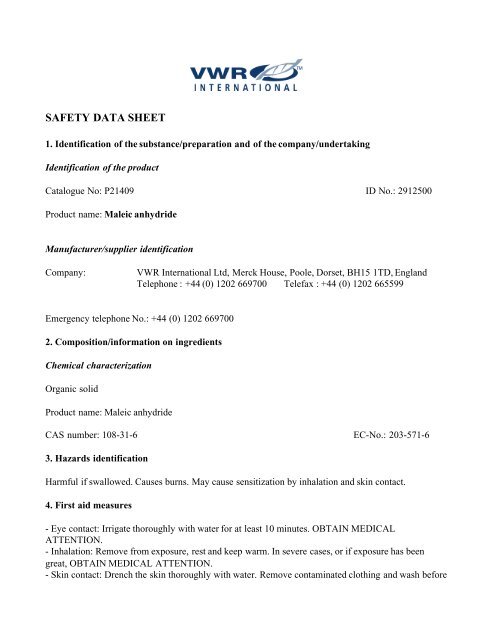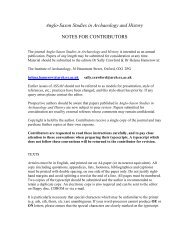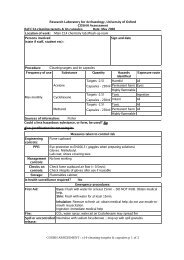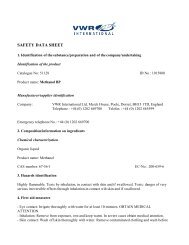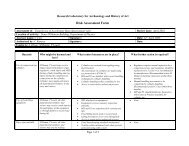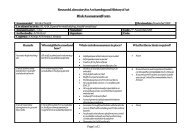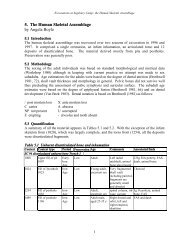Maleic anhydride
Maleic anhydride
Maleic anhydride
You also want an ePaper? Increase the reach of your titles
YUMPU automatically turns print PDFs into web optimized ePapers that Google loves.
SAFETY DATA SHEET<br />
1. Identification of the substance/preparation and of the company/undertaking<br />
Identification of the product<br />
Catalogue No: P21409 ID No.: 2912500<br />
Product name: <strong>Maleic</strong> <strong>anhydride</strong><br />
Manufacturer/supplier identification<br />
Company:<br />
VWR International Ltd, Merck House, Poole, Dorset, BH15 1TD, England<br />
Telephone : +44 (0) 1202 669700 Telefax : +44 (0) 1202 665599<br />
Emergency telephone No.: +44 (0) 1202 669700<br />
2. Composition/information on ingredients<br />
Chemical characterization<br />
Organic solid<br />
Product name: <strong>Maleic</strong> <strong>anhydride</strong><br />
CAS number: 108-31-6 EC-No.: 203-571-6<br />
3. Hazards identification<br />
Harmful if swallowed. Causes burns. May cause sensitization by inhalation and skin contact.<br />
4. First aid measures<br />
- Eye contact: Irrigate thoroughly with water for at least 10 minutes. OBTAIN MEDICAL<br />
ATTENTION.<br />
- Inhalation: Remove from exposure, rest and keep warm. In severe cases, or if exposure has been<br />
great, OBTAIN MEDICAL ATTENTION.<br />
- Skin contact: Drench the skin thoroughly with water. Remove contaminated clothing and wash before
e-use. Unless contact has been slight, OBTAIN MEDICAL ATTENTION.<br />
- Ingestion: Wash out mouth thoroughly with water and give plenty of water to drink. OBTAIN<br />
MEDICAL ATTENTION.<br />
5. Fire-fighting measures<br />
Special risks:<br />
Combustible. May evolve toxic fumes in fire.<br />
Suitable extinguishing media:<br />
Foam, dry powder or carbon dioxide<br />
6. Accidental release measures<br />
Wear appropriate protective clothing.<br />
If local regulations permit, mop up with plenty of water and run to waste, diluting greatly with running<br />
water. Otherwise transfer to container and arrange removal by disposal company. Wash site of spillage<br />
thoroughly with detergent and water.<br />
For large spillages liquids should be contained with sand or earth and both liquids and solids<br />
transferred to salvage containers. Any residues should be treated as for small spillages.<br />
7. Handling and storage<br />
Handling:<br />
Storage:<br />
Store at room temperature (15 to 25°C recommended). Keep well closed and protected from direct<br />
sunlight and moisture.<br />
8. Exposure controls/personal protection<br />
As appropriate to the situation and the quantity handled.<br />
- Respirator: Dust respirator<br />
- Ventilation: Extraction hood<br />
- Gloves: Rubber or plastic<br />
- Eye Protection: Goggles or face-shield<br />
- Other Precautions: Plastic apron, sleeves, boots - if handling large quantities<br />
Engineering methods to control or prevent exposure are preferred. Methods could include process<br />
enclosure or mechanical ventilation.<br />
See section 15 for UK exposure limits.
9. Physical and chemical properties<br />
Form:<br />
Colour:<br />
Odour:<br />
powder/ lumps<br />
white<br />
pungent<br />
Melting temperature 51 - 53°C<br />
Boiling temperature 200°C<br />
Density(g/ml)<br />
n/a<br />
Vapour pressure 1mmHg, 44°C<br />
-Density 3.4<br />
Solubility in water<br />
Soluble<br />
Flash point 103°C<br />
Explosion limits: lower: 1.4%<br />
upper: 7%<br />
Auto-ignition temperature 476°C<br />
10. Stability and reactivity<br />
Stable.<br />
>150#C Exothermic reaction with: alkali compounds, alkaline earth compounds, ammonium<br />
compounds, pyridine, amines.<br />
Substances to be avoided: oxidizing agents.<br />
11. Toxicological information<br />
- After skin contact: Burns.<br />
- After eye contact: Burns.<br />
- After inhalation: Irritation of the mucous membranes, coughing, and dyspnoea., pulmonary oedema.<br />
Systemic effect: asthma.<br />
Ingestion may result in: severe mucosal irritation, gastric pain, vomiting.<br />
Classified as a cause of asthma using EU criteria.<br />
Further hazardous properties cannot be excluded.<br />
Further data<br />
LD50 400 mg/kg oral, rat.<br />
Has been found to cause cancer in laboratory animals. Evidence of reproductive effects.
12. Ecological information<br />
Product reacts with water. Low bioaccumulation potential.<br />
No environmental hazard is anticipated provided that the material is handled and disposed of with due<br />
care and attention.<br />
13. Disposal considerations<br />
Chemical residues are generally classified as special waste, and as such are covered by regulations<br />
which vary according to location. Contact your local waste disposal authority for advice, or pass to a<br />
chemical disposal company. Rinse out empty containers thoroughly before returning for recycling.<br />
14. Transport information<br />
UN-No.: 2215 IMDG class: 8<br />
IMO: 8/2215<br />
Packaging group: III<br />
IATA: 2215<br />
Packaging group: III<br />
Proper shipping name: MALEIC ANHYDRIDE<br />
ADR/RID: 8,31'(c)<br />
15. Regulatory information<br />
Labelling according to EC directives<br />
Symbol: C<br />
Corrosive.<br />
R-phrases: R22-34-42/43<br />
Harmful if swallowed. Causes burns. May cause sensitization by inhalation and skin contact.<br />
S-phrases: S22-26-36/37/39-45<br />
Do not breathe dust. In case of contact with eyes, rinse immediately with plenty of water and seek<br />
medical advice. Wear suitable protective clothing, gloves, and eye/face protection. In case of accident<br />
or if you feel unwell, seek medical advice immediately (show the label where possible).<br />
EC-No.: 203-571-6<br />
Local Regulations<br />
U.K. Transport Category 3<br />
Within the UK, the use of this material must be assessed under the Control of Substances Hazardous to<br />
Health (COSHH) regulations.
UK Exposure Limits: MEL - <strong>Maleic</strong> <strong>anhydride</strong>:<br />
Long term: 1 mg/m3 Short term: 3 mg/m3 (Sen)<br />
16. Other information<br />
Revision.<br />
Supersedes edition of: 12/01/99<br />
Reason for alteration: Changes in Section : 16 (MEL)<br />
Date of issue: 29/12/00<br />
Date of print: 02/05/02


